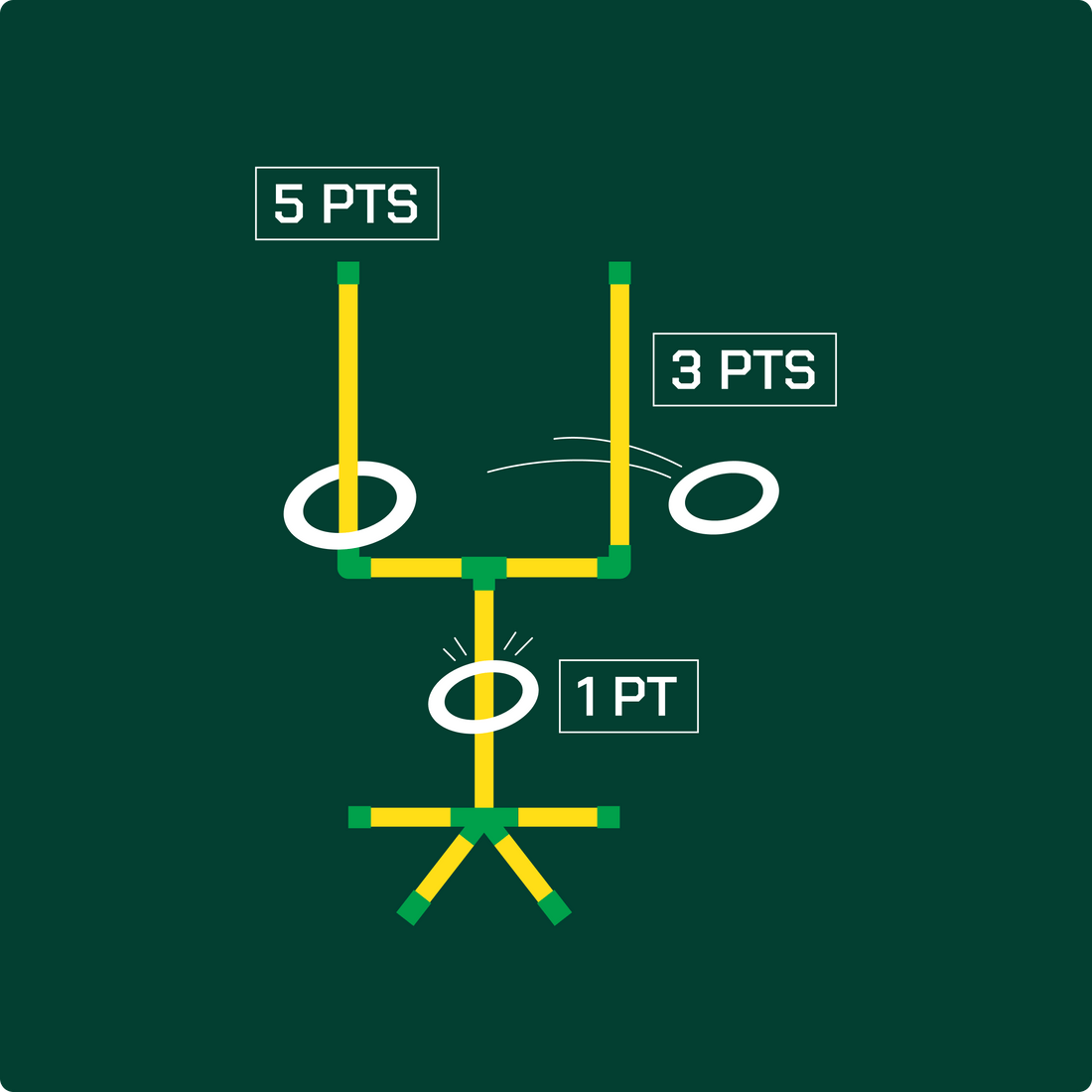Game Rules
How to Play
First-N-Ten is the ultimate outdoor game. Similar to ring toss or frisbee, each team takes their turn to throw their rings and scores points depending on where the rings land. First to 21 points wins.
Quick Start
CHOOSE YOUR PLAY
First-N-Ten can be played by 2 or 4 players. Select your number of players to get started!

- Set goal posts 20 feet apart and facing each other
- Both players stand by the same goal post
- Order of play is determined by a throw of the ring: whoever scores more points decides if they throw first or last in the game
- Player 1 throws both rings, followed by player 2. After each turn (4 throws), the players switch throwing direction together.
- Switch sides and repeat until a player reaches 21 points OR a player rings both uprights for an instant win
- If the player that throws first reaches 21 points, the other player will have one more turn to tie and force a sudden death playoff
Scoring
How to score

Dinger
Ring strikes any part of the goal post (excluding the legs/base)
Field Goal
Ring passes through uprights (may not be above uprights)
Ringer
Ring rings the upright

Instant win
A player rings both uprights on their turn
The Full Rules
Read the full rules here or download a copy of the pamphlet that comes with the First-N-Ten Game Set.
Setup
Assemble the goal posts from the bottom up, matching up the numbers on each piece (see this diagram).
Set the goal posts 20 feet apart and facing each other.
- 2 Players: Players stand on the same side for each turn.
- 4 Players: Teammates stand on opposite sides, facing each other.
Order of Play
- 2 Players: To determine the order of play, each player will get one throw of the ring. Whoever scores more points on their throw will have the choice to throw first or last in the game. If both players tie on their throw, they will both throw again.
- 4 Players: To determine the order of play, each team will get two throws of the ring (1 per player). Whichever team scores more points on their two throws (added together) will have the choice to throw first or last in the game. If both teams tie on their throws, they will repeat the process.
2 Players
Both players stand by the same goal post, throw their rings, and then switch throwing direction together. Player 1 will throw both rings for their turn, followed by Player 2 throwing both their rings. The players will switch sides and repeat until a player reaches exactly 21 points.
After both rings are thrown by Player 1, it is Player 2’s turn to throw. Players repeat this until the game is won.
If the player that throws first scores 21 points during the game and wins, the other player will have one more turn to tie and force a sudden death playoff (see below).
4 Players
First-N-Ten may also be played with 2 teams of 2 players (4 players total). Teammates are to stand at opposite sides of each other, with a full turn for a team consisting of four total throws. Player 1 on the throwing team will throw both rings at the opposite goal post, where his teammate is standing. Player 1’s teammate may deflect the thrown ring toward the goal post to score points. The player deflecting the ring may not catch and release the ring, but may only deflect it. Once Player 1 has thrown both rings, their teammate will repeat the same process, throwing the rings back to Player 1’s goal post, where Player 1 may now deflect the ring if desired. After the throwing team has thrown all four rings, it is the other team’s turn to throw.
This process is repeated until a team has won the game.
If the team that throws first scores 21 points during the game and wins, the other team (throwing second) will still have their turn to tie and force a sudden death playoff (see below).
Deflection
If playing with teams of 2 players, players may deflect their teammate’s throws towards the goal to score points. The player deflecting the ring may not catch and release the ring, but may only deflect it.
Scoring
To win the game a player/team must reach a score of 21 points. If a team/player exceeds 21 points on a turn, they still win the game.
Note: If the winning team went first, the other team still has their turn to hit/exceed 21 points and force a sudden death playoff.
Note: Even if both team’s scores are uneven and both exceed 21 points, the game still goes to a sudden death playoff.
Example: Team 1’s score is at 22 points. Team 2 throws their two rings and has a score of 21 points. This would force a sudden death playoff.
- 1 Point - DINGER: The ring strikes any part of the goal post (upright, cross bar, support bar) without touching the ground.
- 3 Points - FIELD GOAL: The ring flies through the uprights without striking any part of the goal post (must fly directly between the uprights and not above them).
- 5 Points - RINGER: The player rings an upright (ring lands and stays on the upright)Instant Win: A player rings both uprights during their turn (may not ring the same upright twice).
Sudden Death Playoff
2 Players:
- If both players are tied at the end of play, they will enter a sudden death playoff. The order of play will remain the same, with whichever player who threw first in the game throwing first in the sudden death playoff.
- Each player will throw one ring. Whoever scores the most points on their throw will win the game. If the players are tied after their throw, they will throw again until the game is won.
4 Players:
- If both teams are tied at the end of play, they will enter a sudden death playoff. The order of play will remain the same, with whichever team that threw first in the game throwing first in the sudden death playoff.
- Each team will throw two rings (1 per player). Whichever team that scores the most points on their throws (added together) will win the game. If the teams are tied after their throws, they will throw again until the game is won.



